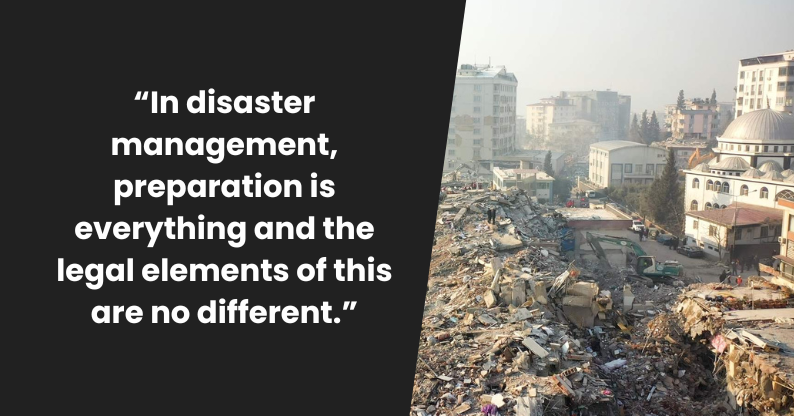Disaster preparedness with Dr John Hopkins
Want to be more prepared for disasters? Learn about disaster management and the law with UC's expert Dr John Hopkins.
Want to be more prepared for disasters? Learn about disaster management and the law with UC's expert Dr John Hopkins.
John Hopkins
Aug 15, 2024
When disaster strikes, gaps in preparedness are exposed and this can lead to slow recovery, higher costs and increased stress on local communities. Dr W. John Hopkins tells us about some of the principles of our online Law and Disaster Risk Reduction course, and why this course is so important and timely.
Dr Hopkins is a Professor of Public Law specialising in law and disasters at Te Whare Wānanga o Waitaha | University of Canterbury. He is also Director of the University of Canterbury Institute of Law, Emergencies and Disasters (LEAD). His research and teaching focuses on recovery governance and international disaster response law.
Why does disaster preparedness require legal frameworks?
Being forewarned is forearmed – or in this case, prepared for a future disaster. Disasters are inevitable and, as we have seen in Canterbury, can have long term impacts many years after the event itself. Legal frameworks are essential to both pre-event (prevention and preparedness) planning as well as the post-event response and recovery. Poor legal frameworks, by contrast, can hamper community efforts to recover well and in extreme cases, even lead to a “second” disaster. For instance, in Canterbury the Canterbury Earthquake Recovery Authority proved to be a problematic model, largely because it was developed in haste, rather than prepared for beforehand.
What disasters have you seen recently that highlight the importance of disaster preparedness and legal frameworks?
There is a rarely a day that goes by where hazards (to use the technical term) don't cause disasters for communities. In almost all these cases, the social elements of the disaster (we call these vulnerabilities) could have been reduced by legal frameworks. For example, building codes in Japan have played a big role in reducing the risk from earthquakes as seen in recent events. While decisions around forestry have had a major impact on the recent disasters in New Zealand (for example, the Christchurch Port Hill Fires and the impacts of Cyclone Gabrielle). Improved planning measures around forestry could reduce this risk.
Natural hazards are part and parcel of the world we live in. By learning how to establish and implement robust legal frameworks, there is an opportunity for any region or country to reduce how vulnerable their communities are to hazards and to increase that community’s resilience.

What about indigenous groups – how is international law and local practice changing to allow more participation from these groups?
Over the last decade, we’ve seen increased recognition of how important indigenous participation can be in preparing for, responding to and recovering from disasters. In Aotearoa, we have seen significant partnerships with Māori iwi and hapu in the response phase. However, as research undertaken by LEAD has shown the relationships rarely extend to the recovery phase. A similar pattern has been recognised in overseas examples.
It has long been acknowledged that the most vulnerable communities suffer the most in disaster events and poor involvement with indigenous communities, who are often already marginalised, can lead to poor outcomes after a disaster. In addition, indigenous communities often hold extensive knowledge resources that, if effectively harnessed in a genuine partnership with the state can benefit indigenous communities and the wider community. This is an area which we at LEAD hope to study further in the future.
Who is in the firing line when disaster strikes? How could professionals in these organisations benefit from learning about disaster law?
Regional and local councils, central government, planners and emergency management volunteers or employees are all placed under huge pressure when disaster strikes. If you work within any of these organisations or roles, our Law and Disaster Risk Reduction course covers all the basics for how to understand and identify the legal frameworks needed to reduce vulnerabilities and thus prevent or mitigate hazards. It also introduces the issues which need to be considered when a disaster strikes.
In disaster management, preparation is everything and the legal elements of this are no different. This course aims to provide professionals involved in disaster risk management (at all levels) with the tools to engage and understand the legal frameworks at the heart of disaster risk reduction.
The worst time to need to learn this is on the day of the event itself. Legal preparedness matters!
Find out more about Law and Disaster Risk Reduction and sign up online.
Be the first to know about our new programmes and other online updates by subscribing to our newsletter.
Follow us on LinkedIn for the latest learning updates.